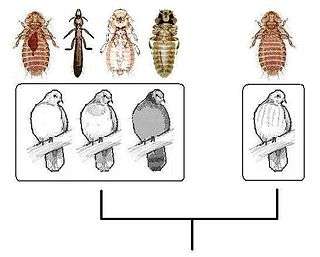Eichler's rule
Parasites tend to be highly specific to their hosts, thus it seems reasonable to expect a positive co-variation between the taxonomic richness of hosts and that of their parasites. Wolfdietrich Eichler (1912–1994), a German authority in zoology and parasitology[1] was the first to point out this relationship in 1942 and it was later dubbed 'Eichler’s rule'. It is one of the first three coevolutionary rules.[2]

When comparing host sister clades we tend to find taxonomically richer parasite fauna on the taxonomically richer group of hosts.
Recently, Vas and his co-authors[3] tested Eichler's rule, and concluded that exceptionally strong correlational evidence supports the positive co-variation between the species richness of avian and mammalian families and the generic richness of their parasitic lice.
References
- Eichler, W. (1942). "Die Entfaltungsregel und andere Gesetzmäßigkeiten in den parasitogenetischen Beziehungen der Mallophagen und anderer ständiger Parasiten zu ihren Wirten" (PDF). Zoologischer Anzeiger. 136: 77–83.
- Klassen, G. J. (1992). "Coevolution: a history of the macroevolutionary approach to studying host-parasite associations". Journal of Parasitology. 78 (4): 573–587. doi:10.2307/3283532. JSTOR 3283532. PMID 1635016.
- Vas, Z.; Csorba, G.; Rozsa, L. (2012). "Evolutionary co-variation of host and parasite diversity – the first test of Eichler's rule using parasitic lice (Insecta: Phthiraptera)" (PDF). Parasitology Research. 111: 393–401. doi:10.1007/s00436-012-2850-9. PMID 22350674.
This article is issued from Wikipedia. The text is licensed under Creative Commons - Attribution - Sharealike. Additional terms may apply for the media files.
